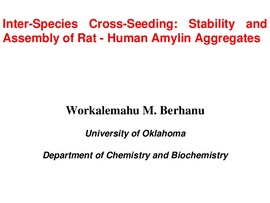| dc.creator | Berhanu, Workalemahu M. | |
| dc.date.accessioned | 2015-07-16T19:13:01Z | |
| dc.date.available | 2015-07-16T19:13:01Z | |
| dc.date.issued | 2014-09-24 | |
| dc.identifier.uri | https://hdl.handle.net/11244/15237 | |
| dc.description | Workalemahu M. Berhanu graduated in 2011 from the University of Central Florida with a PhD in Chemistry. Since January 2012, he has been working in Prof. Ulrich Hansmann's group in the Department of Chemistry & Biochemistry at the University of Oklahoma as postdoctoral research associate. His research interest has been targeted towards understanding the mechanism of protein folding, protein mis-folding, protein aggregation, cross seeding of aggregates, toxicity mechanism and their inhibition based on bimolecular simulations. | en_US |
| dc.description | Presented at the Oklahoma Supercomputing Symposium 2014, September 23, 2014. | |
| dc.description.abstract | Diseases such as type 2 diabetes, Alzheimer's and Parkinson's share as a common feature the accumulation of mis-folded disease-specific protein aggregates into fibrillar structures, or plaques. These fibrils may either be toxic by themselves, or act as reservoirs for smaller cytotoxic oligomers. This suggests to investigate molecules as potential therapeutics that either reduce fibril formation or increase fibril stability. One example is rat amylin, which can inhibit aggregation of human amylin, a hallmark of type 2 diabetes. We use molecular dynamics to compare the stability of various preformed aggregates, built out of either human amylin, rat amylin, or mixtures of both. We considered two types of fibril-like oligomers: a single-layer in-register conformation, and a double-layer conformation in which the first U-shaped layer consists of rat amylin and the second layer of human amylin. Our results explain the weak amyloid-inhibiting properties of rat amylin and suggest that membrane leakage due to pore formation is responsible for the toxicity of rat amylin observed in a recent experiment. Together, our results put in question the use of rat amylin or the similar FDA approved drug pramlintide as an inhibitor of human amylin aggregation. They also point to mixed human-rat amylin fibril-like oligomers as possible model-systems for studies of amyloid formation that involve cross-species transmission. | en_US |
| dc.description.sponsorship | Oklahoma Supercomputing Symposium 2014
The University of Oklahoma
The University of Oklahoma
Department of Information Technology
The University of Oklahoma Supercomputing Center for Education and Research (OSCER)
The University of Oklahoma Department of Chemistry and Biochemistry | en_US |
| dc.format.extent | 17 pages | |
| dc.format.extent | 1,714,502 bytes | |
| dc.format.medium | application.pdf | |
| dc.language | en_US | en_US |
| dc.relation.requires | Adobe Acrobat Reader | |
| dc.subject.lcsh | Amylin -- Therapeutic use | en_US |
| dc.subject.lcsh | Protein folding -- Prevention | en_US |
| dc.subject.lcsh | Aggregation (Chemistry) | en_US |
| dc.subject.lcsh | Rats -- Molecular aspects | en_US |
| dc.title | Inter-species cross-seeding : stability and assembly of rat-human amylin aggregates | en_US |
| dc.type | Presentation | en_US |
| dc.type | still image | |
| dc.description.peerreview | No | en_US |
| ou.group | Oklahoma Supercomputing::Oklahoma Supercomputing Symposium::2014 | |
| shareok.orcid | 0000-0002-0252-7485 | |
